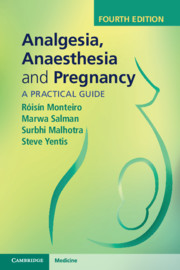Book contents
- Analgesia, Anaesthesia and Pregnancy
- Analgesia, Anaesthesia and Pregnancy
- Copyright page
- Contents
- Preface
- Section 1 Pre-conception and conception
- Section 2 Pregnancy
- I Procedures in Early and Mid-Pregnancy
- II Normal pregnancy and delivery
- III Operative Delivery and the Third Stage
- IV Anaesthetic problems
- V Problems confined to obstetrics
- VI Problems not confined to obstetrics
- Chapter 90 Allergic reactions
- Chapter 91 Cardiovascular disease
- Chapter 92 Arrhythmias
- Chapter 93 Pulmonary oedema
- Chapter 94 Cardiomyopathy
- Chapter 95 Coarctation of the aorta
- Chapter 96 Aortic dissection
- Chapter 97 Valvular heart disease
- Chapter 98 Congenital heart disease
- Chapter 99 Pulmonary hypertension and Eisenmenger’s syndrome
- Chapter 100 Ischaemic heart disease
- Chapter 101 Endocrine disease
- Chapter 102 Diabetes mellitus
- Chapter 103 Anaemia and polycythaemia
- Chapter 104 Deep-vein thrombosis and pulmonary embolism
- Chapter 105 Thrombophilia
- Chapter 106 Coagulopathy
- Chapter 107 Von Willebrand’s disease and haemophilia
- Chapter 108 Disseminated intravascular coagulation
- Chapter 109 Thrombocytopenia
- Chapter 110 Lymphoma and leukaemia
- Chapter 111 Haemoglobinopathies
- Chapter 112 Connective tissue disorders
- Chapter 113 Rheumatoid arthritis
- Chapter 114 Cervical spine disorders
- Chapter 115 Kyphoscoliosis
- Chapter 116 Low back pain in pregnancy
- Chapter 117 The parturient with chronic pain
- Chapter 118 Neurological disease
- Chapter 119 Meningitis
- Chapter 120 Acute post-infective peripheral neuropathy (Guillain–Barré syndrome)
- Chapter 121 Past history of neurological trauma
- Chapter 122 Idiopathic intracranial hypertension
- Chapter 123 Intracranial tumour
- Chapter 124 Neurofibromatosis
- Chapter 125 Stroke
- Chapter 126 Epilepsy
- Chapter 127 Convulsions
- Chapter 128 Migraine
- Chapter 129 Multiple sclerosis
- Chapter 130 Myasthenia gravis
- Chapter 131 Spina bifida
- Chapter 132 Respiratory disease
- Chapter 133 Asthma
- Chapter 134 Cystic fibrosis
- Chapter 135 Pulmonary fibrosis
- Chapter 136 Sarcoidosis
- Chapter 137 Acute lung injury and acute respiratory distress syndrome
- Chapter 138 Pneumonia
- Chapter 139 Sepsis
- Chapter 140 Hepatitis
- Chapter 141 Herpes simplex infection
- Chapter 142 HIV infection
- Chapter 143 Malaria in pregnancy
- Chapter 144 Pyrexia during labour
- Chapter 145 Migrants and other disadvantaged women
- Chapter 146 Psychiatric disease
- Chapter 147 Substance abuse
- Chapter 148 Obesity
- Chapter 149 Kidney disease
- Chapter 150 Steroid therapy
- Chapter 151 Trauma in pregnancy
- Chapter 152 Jehovah’s witnesses
- Chapter 153 Malignant disease
- Chapter 154 Transplantation
- Chapter 155 Critical care in pregnancy
- Chapter 156 Modified early obstetric warning scores
- Chapter 157 Invasive monitoring
- Section 3 Puerperium and after
- Section 4 Organisational issues
- Index
- References
Chapter 90 - Allergic reactions
from VI - Problems not confined to obstetrics
Published online by Cambridge University Press: 29 April 2019
- Analgesia, Anaesthesia and Pregnancy
- Analgesia, Anaesthesia and Pregnancy
- Copyright page
- Contents
- Preface
- Section 1 Pre-conception and conception
- Section 2 Pregnancy
- I Procedures in Early and Mid-Pregnancy
- II Normal pregnancy and delivery
- III Operative Delivery and the Third Stage
- IV Anaesthetic problems
- V Problems confined to obstetrics
- VI Problems not confined to obstetrics
- Chapter 90 Allergic reactions
- Chapter 91 Cardiovascular disease
- Chapter 92 Arrhythmias
- Chapter 93 Pulmonary oedema
- Chapter 94 Cardiomyopathy
- Chapter 95 Coarctation of the aorta
- Chapter 96 Aortic dissection
- Chapter 97 Valvular heart disease
- Chapter 98 Congenital heart disease
- Chapter 99 Pulmonary hypertension and Eisenmenger’s syndrome
- Chapter 100 Ischaemic heart disease
- Chapter 101 Endocrine disease
- Chapter 102 Diabetes mellitus
- Chapter 103 Anaemia and polycythaemia
- Chapter 104 Deep-vein thrombosis and pulmonary embolism
- Chapter 105 Thrombophilia
- Chapter 106 Coagulopathy
- Chapter 107 Von Willebrand’s disease and haemophilia
- Chapter 108 Disseminated intravascular coagulation
- Chapter 109 Thrombocytopenia
- Chapter 110 Lymphoma and leukaemia
- Chapter 111 Haemoglobinopathies
- Chapter 112 Connective tissue disorders
- Chapter 113 Rheumatoid arthritis
- Chapter 114 Cervical spine disorders
- Chapter 115 Kyphoscoliosis
- Chapter 116 Low back pain in pregnancy
- Chapter 117 The parturient with chronic pain
- Chapter 118 Neurological disease
- Chapter 119 Meningitis
- Chapter 120 Acute post-infective peripheral neuropathy (Guillain–Barré syndrome)
- Chapter 121 Past history of neurological trauma
- Chapter 122 Idiopathic intracranial hypertension
- Chapter 123 Intracranial tumour
- Chapter 124 Neurofibromatosis
- Chapter 125 Stroke
- Chapter 126 Epilepsy
- Chapter 127 Convulsions
- Chapter 128 Migraine
- Chapter 129 Multiple sclerosis
- Chapter 130 Myasthenia gravis
- Chapter 131 Spina bifida
- Chapter 132 Respiratory disease
- Chapter 133 Asthma
- Chapter 134 Cystic fibrosis
- Chapter 135 Pulmonary fibrosis
- Chapter 136 Sarcoidosis
- Chapter 137 Acute lung injury and acute respiratory distress syndrome
- Chapter 138 Pneumonia
- Chapter 139 Sepsis
- Chapter 140 Hepatitis
- Chapter 141 Herpes simplex infection
- Chapter 142 HIV infection
- Chapter 143 Malaria in pregnancy
- Chapter 144 Pyrexia during labour
- Chapter 145 Migrants and other disadvantaged women
- Chapter 146 Psychiatric disease
- Chapter 147 Substance abuse
- Chapter 148 Obesity
- Chapter 149 Kidney disease
- Chapter 150 Steroid therapy
- Chapter 151 Trauma in pregnancy
- Chapter 152 Jehovah’s witnesses
- Chapter 153 Malignant disease
- Chapter 154 Transplantation
- Chapter 155 Critical care in pregnancy
- Chapter 156 Modified early obstetric warning scores
- Chapter 157 Invasive monitoring
- Section 3 Puerperium and after
- Section 4 Organisational issues
- Index
- References
- Type
- Chapter
- Information
- Analgesia, Anaesthesia and PregnancyA Practical Guide, pp. 271 - 273Publisher: Cambridge University PressPrint publication year: 2019



